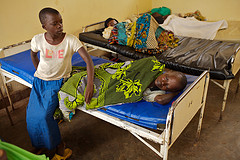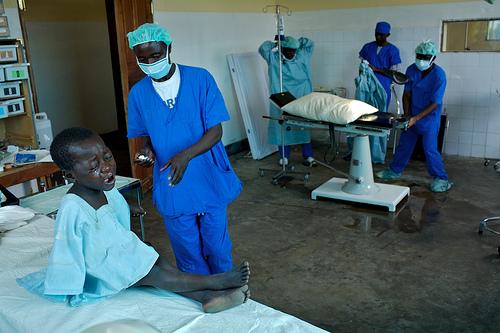 Ongoing fighting in eastern Democratic Republic of Congo (DRC) continues to take its toll on women's health.
Ongoing fighting in eastern Democratic Republic of Congo (DRC) continues to take its toll on women's health.
Throughout the conflict women have been brutalized by rape and sexual violence. An estimated 200,000 women and girls have been assaulted over the past 12 years, with more than 18,000 cases reported between January and September 2008. This past May, the U.S. Senate foreign relations committee held a hearing to address how rape is being used as a weapon of war in the DRC.
Often this rape takes on extremely violent forms and can cause injuries to a woman's reproductive organs. For instance, it can cause a health condition called vaginal fistula, which happens when the wall between a woman's vagina and the bladder and/or rectum tears. Also called traumatic fistula when caused by sexual violence, it's hard to know how many women in the DRC have this condition. But it's been estimated that thousands of Congolese girls and women have been impacted, and one assessment of six DRC provinces found that out of 432 fistula cases, around14 percent were because of trauma.
Jim Bliss, blogging on The Quiet Road, elaborates on the situation. He says:
“In the rest of the world the condition [fistula] generally occurs due to serious complications during childbirth. Most gynecologists and obstetricians will go their entire career without ever encountering a single case. In DRC, however, there’s an epidemic. And it’s not down to an increase in complicated births.
Many of the militias in DRC have adopted a deliberate policy of terror through mass rape…However rape – even violent rape – does not as a rule cause fistula. No, instead the militiamen, having already gang-raped the woman (often a huge number of times over a period of weeks or months) will deliberately inflict major damage to her genitals before sending her back to her village. More often than not this is achieved by carefully shooting the woman’s vagina at point-blank range…Knives, broken glass or just sharp sticks are [also] used to cause as much damage as possible. Girls as young as 12 months have been subjected to this violence.”
Medical complications for women with fistula can include being permanently incontinent, infertility, miscarriages, and other health problems. On top of this, women with fistula often face stigma because of their status as a rape victim, as well as their chronic incontinence.
Many wounded women are unable to get treatment, but there are some medical centers that treat rape-related injuries, including fistula. One such center is the Panzi Hospital in Bukavu, which was created in 1999. Surgeons at the hospital performed 540 fistula repairs in 2005, 80 percent of which were due to sexual violence. In this video, a psychologist at the Panzi Hospital shows what life is like for women seeking treatment for traumatic fistula.
Endre Vestvik visited the hospital and took a series of photos of women and girls being treated for fistula. This is a photo of 4-year-old Vitonsi, who is preparing for fistula surgery. She was raped by soldiers when trying to cross the river with her pregnant mom and her sister.

Gypsy Girl Chronicles also went to Panzi Hospital and describes her experience:
“Doctors here specialize in fistula operation and women travel here from far and wide for a cure. I met one woman here who was raped and tortured at the age of 17 during the height of the war. She has been at the hospital, away from her family for over 6 years now enduring one operation after another. She said that she did not feel human anymore and had no future.”
A hospital in Goma is also working to treat women who have fistula. This video shows a young woman with the condition being taken to the DOCS Hospital, where other women are recovering from treatment.
Despite the positive work being done by these hospitals, Emin Pasha, blogging on Congo Resources, felt highly discouraged after learning more about sexual violence in the DRC.
“Little is being done about the problem, despite the fact that rape in eastern Congo has become such a well-known and well-publicized problem. Research on the topic remains preliminary; there are still only a handful of clinics and hospitals addressing the needs of the women; police and local authorities still don't have any capacity or willingness to protect the population; and overall it appears that the problem is getting worse not better.”
Still, Brad MacIntosh, blogging on A wide-angle view of the DRC conflict, says his visit to the Panzi Hospital in June gave him a glimmer of hope.
“It is hard to describe all the emotions as I walked through the open corridors of the hospital complex on a warm and sunny day. I headed towards the operating theatres and found that the second building is now fully operational. This operating theater is for surgical repair of women who have survived rape. Surgeries are performed by the head fistula surgeon, a gentle and wise doctor named Dr Yunga who I met previously. Beyond this building is a beautiful courtyard where survivors of rape have a place to call their own, where they have workshops, sing, cook and learn skills…I have seen evidence of remarkable progress at Panzi Hospital. Layers of progress in fact, which leads me to conclude it is a place of immense potential and optimism in city that has seen too much despair.”
Photo of Waiting for Treatment by Endre Vestvik (cyclopsr) on Flickr.







12 comments
What is exactly the point of this post?
You use photos of 2006 (including a 4 year old raped child who, if you ask Unicef or anyone working in children’s rights or child protection will tell you that it’s not acceptable), and you quote a blog post from 2007. Besides, everything you quote is from expats visiting Panzi (most probably all American) giving very superficial analysis of the rape “epidemic” (would you say there’s a shooting epidemic in the US? It sure looks like that from here)
Yes, rape is still going on in Eastern DRC, and the conflict is far from being solved. But you could have bothered to look for more recent assessments and blogs about it and perhaps to actually quote some African bloggers. This is the kind of sensationalist and pointless coverage about the Congo and Africa that we loathe, leaving the impression that it’s all rape, rape, rape, and helpless victims that have no voice but through saintly Western visitors.
Are you sick? You seriously are curious why this is being exposed? It’s nothing wrong with showing a picture of a fully clothed child sitting on a hospital bed. Something is seriously wrong with you. Are you some kind of demon, or a rapist yourself, or just mentally depraved. They have a voice through western visitors, where do you think the camera came from, you’re the one who wants to take the voice away. You work with the rapists, you are a sick depraved individual!
The NY Times reported on this today (taking the angle that men are now being raped, too):
“Last year, Congo’s rape epidemic appeared to be easing a bit, with fewer cases reported and some rapists jailed. But today, it seems like that thin veneer of law and order has been stripped away. The way villagers describe it, it is open season on civilians.”
Seems like it’s not just continuing, it’s getting worse.
And as for the idea that it’s just another example of bad news to make Africa look bad, I’m not sure how pretending that a problem doesn’t exist is going to improve anything… let alone rape, which is a horrendous crime of power and humiliation. Hiding it only empowers the rapists!
Here’s the link: http://www.nytimes.com/2009/08/05/world/africa/05congo.html?em
Well said, I appreciate you. Me looking bad doesn’t compare to what happened to these women and children. I’m about to burst because I feel so helpless except to pray which I know works. Every race of people have embarrassing stains. What happened in Sudan I hated and I hate this and am furious with any countries leader claiming to get rid of terrorists and fight for gay rights and ignore this issue. Where are the US jets overhead targeting the soldiers camps, where are the marines to bust this regime wide open. I hate hypocrisy!
I read this and my heart sank. :(
What to do?!